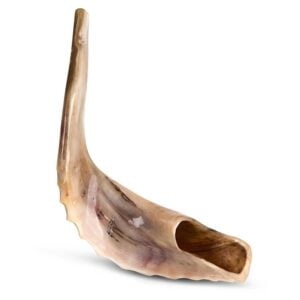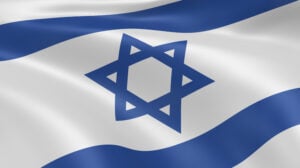
The month of Elul in the Hebrew calendar is almost upon us, which means now is the perfect time to brush up on the meaning behind your favorite High Holiday traditions! While the story behind some of the foods and rituals associated with Rosh Hashanah and Yom Kippur can be easy to guess, there are just as many that are less obvious. The shofar (ram’s horn) is a perfect example of a classic High Holiday symbol that is more baffling.
Unsure of what the shofar symbolizes? Wondering who blows the shofar? This guide will answer all of your questions about the shofar, just in time for Rosh Hashanah 2023!

What is a shofar?
A shofar (שופר) is an ancient musical instrument, similar to a horn or trumpet, that has been used by Jews for thousands of years. The sounds of the shofar have been deployed on a variety of occasions throughout Jewish history, including to announce a new moon, the start of a jubilee year, or when Shabbat approached, as well as to warn communities of the beginning of a battle or war. Before the destruction of the Temple, a shofar would be blown alongside a trumpet by the Temple’s orchestra.
In Hebrew, the word shofar literally means ram’s horn. The word shofroth is the plural form of shofar.
When is a shofar used today?
In modern times, someone blasts the shofar every day during morning prayer services in synagogue throughout the month of Elul, except on Shabbat. The shofar is also used during Rosh Hashanah prayer services and at the end of Yom Kippur to signify the end of the fast.
Why isn’t a shofar used on Shabbat?
While shofroth were historically used on Shabbat in the Temple, rabbis later outlawed this practice after the destruction of the Temple out of concern that the ba’al tekiah (the Hebrew word for the shofar blower) would accidentally carry the shofar and violate the prohibition of carrying on Shabbat.

Is the shofar mentioned in the Torah?
Yes! The shofar is first mentioned in the Torah in Exodus, when God says the Israelites will hear the “long blast” of a ram’s horn, signaling that they can go up to Mount Sinai to meet God. The experience of the horn blasting made the Israelites tremble, and the sound became louder and louder.
The commandment to blast the shofar specifically on Rosh Hashanah is found later in the Torah, in the Book of Leviticus. The significance of sounding the shofar is also mentioned throughout the Talmud, Biblical commentaries, and Midrash, with many great thinkers in Judaism drawing connections between the story of Abraham binding Isaac and the shofar.

How is Abraham related to the shofar or the Jewish New Year?
While Abraham does not sound the shofar anywhere in Genesis, a ram plays a major role in the story of binding of Isaac. According to Genesis, a ram was caught in a bush by its horns nearby and was ultimately sacrificed instead of Isaac. This story is read in synagogue on the second day of Rosh Hashanah, as many believe that the binding occurred on the Jewish New Year.
In addition, many commentators have also found significance and connections between Abraham binding Isaac and the use of (and preference for) a ram’s horn in Judaism as a wake up call. In the Talmud, Rabbi Abihu says the shofar is sounded on Rosh Hashanah because “The Holy One, Blessed be God, said: Sound before Me a shofar so that I may remember on your behalf the binding of Isaac, the son of Abraham, and account it to you as if you had been bound yourselves before Me.”
Who can blow the shofar on Rosh Hashanah and Yom Kippur?
Since blowing the shofar is a time-bound commandment, traditional Jewish communities hold that only men can fulfill the mitzvah of blowing the shofar. However, Orthodox halacha (Jewish law) does note that a woman can blow a shofar for other women to hear.
Otherwise, traditional Jewish law says that whoever sounds the ram’s horn must be learned, above bar mitzvah age, and cannot be a slave. However, it is important to note that the mitzvah (commandment) is to hear the shofar blasts, not to do them yourself, even if you are eligible according to your community’s norms.

Do different shofar blasts mean different things? Is there a specific order?
Yes! There are three main types of blasts: Tekiah (תקיעה), Shevarim (שברים), and Teruah (תרועה). You will hear all three of these blasts on the holiday of Rosh Hashanah. On Yom Kippur, some communities will utilize all three of these blasts, while others only blow the Tekiah Gedolah. The order of the blasts depends on the day and specific prayer service.
Tekiah is one single long blast of the shofar, while Shevarim is three short blasts that are sounded one right after the other. Teruah is a series of short blasts, also done in quick succession. Tekiah Gedolah is when someone blows the shofar once for as long as they can.
Tekiah is meant to bring us to attention, while Shevarim is meant to sound like crying.
Does a ram’s horn have to be used to make a shofar? Can we use other animals?
While a shofar is always made from an animal’s horns, a ram doesn’t necessarily have to be used. In Temple times, the horn often came from a goat. The Talmud later decided that any animal from the bovidae family (פריים in Hebrew) can be used, although ram and sheep are preferable. In North African and Yemenite communities, horns from the kudu animal, a type of antelope, are often used. Since the horn is not consumed, there is no need for the shofar to be sourced from a kosher animal.
How do I choose the shofar that is right for me?
The most important thing to keep in mind before you place an order for your shofar is that some communities have varying norms about the use of different animals. If you’re unsure, ask a trusted rabbi before purchasing. You can also take a look at our guide to buying the perfect shofar to ensure that whatever shofar you order from our website will be suitable for your needs.
Ready to buy your very own shofar? Check out all the amazing shofars on our site, as well as our top 10 guide to the most beautiful and special shofars from Israel – great as Rosh Hashanah gifts for your loved ones!












